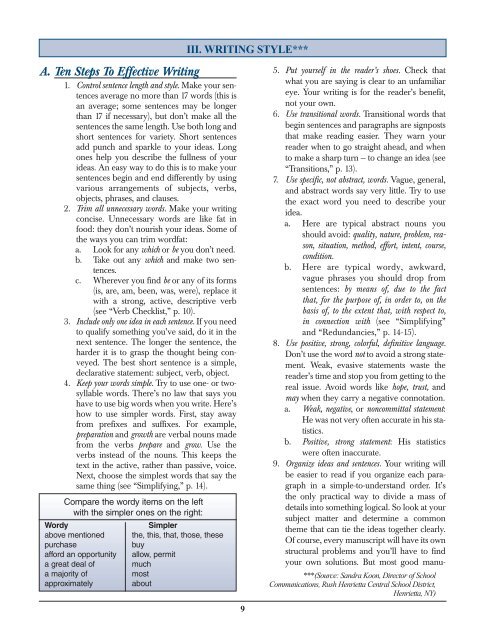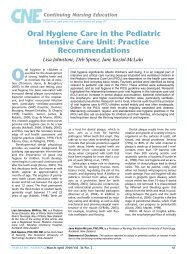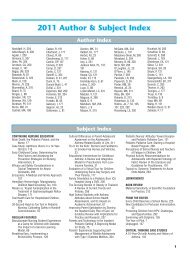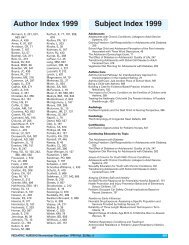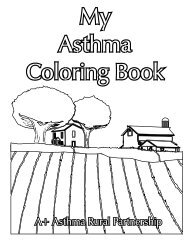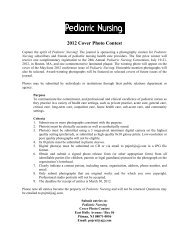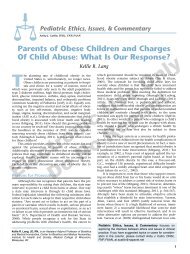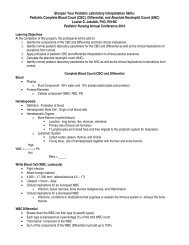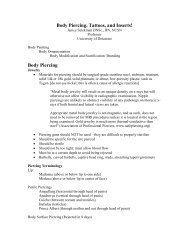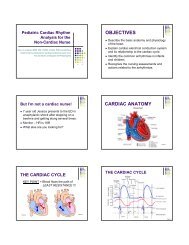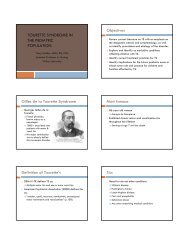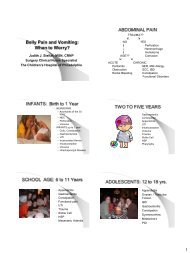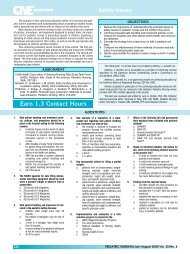Jannetti Publications Guidelines For Authors - Pediatric Nursing
Jannetti Publications Guidelines For Authors - Pediatric Nursing
Jannetti Publications Guidelines For Authors - Pediatric Nursing
Create successful ePaper yourself
Turn your PDF publications into a flip-book with our unique Google optimized e-Paper software.
III. WRITING STYLE***<br />
A. Ten Steps To Effective Writing<br />
1. Control sentence length and style. Make your sentences<br />
average no more than 17 words (this is<br />
an average; some sentences may be longer<br />
than 17 if necessary), but don’t make all the<br />
sentences the same length. Use both long and<br />
short sentences for variety. Short sentences<br />
add punch and sparkle to your ideas. Long<br />
ones help you describe the fullness of your<br />
ideas. An easy way to do this is to make your<br />
sentences begin and end differently by using<br />
various arrangements of subjects, verbs,<br />
objects, phrases, and clauses.<br />
2. Trim all unnecessary words. Make your writing<br />
concise. Unnecessary words are like fat in<br />
food: they don’t nourish your ideas. Some of<br />
the ways you can trim wordfat:<br />
a. Look for any which or be you don’t need.<br />
b. Take out any which and make two sentences.<br />
c. Wherever you find be or any of its forms<br />
(is, are, am, been, was, were), replace it<br />
with a strong, active, descriptive verb<br />
(see “Verb Checklist,” p. 10).<br />
3. Include only one idea in each sentence. If you need<br />
to qualify something you’ve said, do it in the<br />
next sentence. The longer the sentence, the<br />
harder it is to grasp the thought being conveyed.<br />
The best short sentence is a simple,<br />
declarative statement: subject, verb, object.<br />
4. Keep your words simple. Try to use one- or twosyllable<br />
words. There’s no law that says you<br />
have to use big words when you write. Here’s<br />
how to use simpler words. First, stay away<br />
from prefixes and suffixes. <strong>For</strong> example,<br />
preparation and growth are verbal nouns made<br />
from the verbs prepare and grow. Use the<br />
verbs instead of the nouns. This keeps the<br />
text in the active, rather than passive, voice.<br />
Next, choose the simplest words that say the<br />
same thing (see “Simplifying,” p. 14).<br />
Compare the wordy items on the left<br />
with the simpler ones on the right:<br />
Wordy<br />
Simpler<br />
above mentioned the, this, that, those, these<br />
purchase<br />
buy<br />
afford an opportunity allow, permit<br />
a great deal of much<br />
a majority of<br />
most<br />
approximately about<br />
9<br />
5. Put yourself in the reader’s shoes. Check that<br />
what you are saying is clear to an unfamiliar<br />
eye. Your writing is for the reader’s benefit,<br />
not your own.<br />
6. Use transitional words. Transitional words that<br />
begin sentences and paragraphs are signposts<br />
that make reading easier. They warn your<br />
reader when to go straight ahead, and when<br />
to make a sharp turn — to change an idea (see<br />
“Transitions,” p. 13).<br />
7. Use specific, not abstract, words. Vague, general,<br />
and abstract words say very little. Try to use<br />
the exact word you need to describe your<br />
idea.<br />
a. Here are typical abstract nouns you<br />
should avoid: quality, nature, problem, reason,<br />
situation, method, effort, intent, course,<br />
condition.<br />
b. Here are typical wordy, awkward,<br />
vague phrases you should drop from<br />
sentences: by means of, due to the fact<br />
that, for the purpose of, in order to, on the<br />
basis of, to the extent that, with respect to,<br />
in connection with (see “Simplifying”<br />
and “Redundancies,” p. 14-15).<br />
8. Use positive, strong, colorful, definitive language.<br />
Don’t use the word not to avoid a strong statement.<br />
Weak, evasive statements waste the<br />
reader’s time and stop you from getting to the<br />
real issue. Avoid words like hope, trust, and<br />
may when they carry a negative connotation.<br />
a. Weak, negative, or noncommittal statement:<br />
He was not very often accurate in his statistics.<br />
b. Positive, strong statement: His statistics<br />
were often inaccurate.<br />
9. Organize ideas and sentences. Your writing will<br />
be easier to read if you organize each paragraph<br />
in a simple-to-understand order. It’s<br />
the only practical way to divide a mass of<br />
details into something logical. So look at your<br />
subject matter and determine a common<br />
theme that can tie the ideas together clearly.<br />
Of course, every manuscript will have its own<br />
structural problems and you’ll have to find<br />
your own solutions. But most good manu-<br />
***(Source: Sandra Koon, Director of School<br />
Communications, Rush Henrietta Central School District,<br />
Henrietta, NY)


